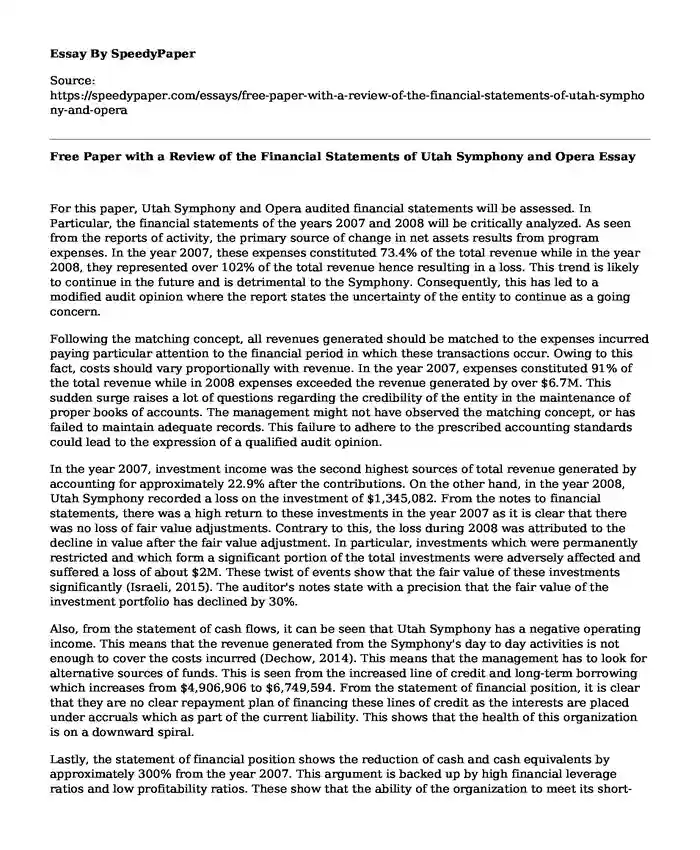
| Type of paper: | Research paper |
| Categories: | Audit Financial analysis |
| Pages: | 3 |
| Wordcount: | 692 words |
For this paper, Utah Symphony and Opera audited financial statements will be assessed. In Particular, the financial statements of the years 2007 and 2008 will be critically analyzed. As seen from the reports of activity, the primary source of change in net assets results from program expenses. In the year 2007, these expenses constituted 73.4% of the total revenue while in the year 2008, they represented over 102% of the total revenue hence resulting in a loss. This trend is likely to continue in the future and is detrimental to the Symphony. Consequently, this has led to a modified audit opinion where the report states the uncertainty of the entity to continue as a going concern.
Following the matching concept, all revenues generated should be matched to the expenses incurred paying particular attention to the financial period in which these transactions occur. Owing to this fact, costs should vary proportionally with revenue. In the year 2007, expenses constituted 91% of the total revenue while in 2008 expenses exceeded the revenue generated by over $6.7M. This sudden surge raises a lot of questions regarding the credibility of the entity in the maintenance of proper books of accounts. The management might not have observed the matching concept, or has failed to maintain adequate records. This failure to adhere to the prescribed accounting standards could lead to the expression of a qualified audit opinion.
In the year 2007, investment income was the second highest sources of total revenue generated by accounting for approximately 22.9% after the contributions. On the other hand, in the year 2008, Utah Symphony recorded a loss on the investment of $1,345,082. From the notes to financial statements, there was a high return to these investments in the year 2007 as it is clear that there was no loss of fair value adjustments. Contrary to this, the loss during 2008 was attributed to the decline in value after the fair value adjustment. In particular, investments which were permanently restricted and which form a significant portion of the total investments were adversely affected and suffered a loss of about $2M. These twist of events show that the fair value of these investments significantly (Israeli, 2015). The auditor's notes state with a precision that the fair value of the investment portfolio has declined by 30%.
Also, from the statement of cash flows, it can be seen that Utah Symphony has a negative operating income. This means that the revenue generated from the Symphony's day to day activities is not enough to cover the costs incurred (Dechow, 2014). This means that the management has to look for alternative sources of funds. This is seen from the increased line of credit and long-term borrowing which increases from $4,906,906 to $6,749,594. From the statement of financial position, it is clear that they are no clear repayment plan of financing these lines of credit as the interests are placed under accruals which as part of the current liability. This shows that the health of this organization is on a downward spiral.
Lastly, the statement of financial position shows the reduction of cash and cash equivalents by approximately 300% from the year 2007. This argument is backed up by high financial leverage ratios and low profitability ratios. These show that the ability of the organization to meet its short-term obligations is impaired and is faced with a risk of being liquidated (Gombola et al. 2016).
In conclusion, from the above discussion, it is clear that the going concern of Utah Symphony is not absolute and therefore the firm faces a risk of curtailing its activities and ceasing its operations. The auditor's notes also explicitly state on their uncertainty of the entity to continue as a going concern. Therefore, it is reasonable to say that the future economic viability of the organization is not feasible.
References
Dechow, P. M. (2014). Accounting earnings and cash flows as measures of firm performance: The role of accounting accruals. Journal of accounting and economics, 18(1), 3-42.
Gombola, M. J., Ho, A. Y. F., & Huang, C. C. (2016). The effect of leverage and liquidity on earnings and capital management: Evidence from US commercial banks. International Review of Economics & Finance, 43, 35-58.
Israeli, D. (2015). Recognition versus disclosure: evidence from the fair value of investment property. Review of Accounting Studies, 20(4), 1457-1503.
Cite this page
Free Paper with a Review of the Financial Statements of Utah Symphony and Opera. (2022, May 06). Retrieved from https://speedypaper.com/essays/free-paper-with-a-review-of-the-financial-statements-of-utah-symphony-and-opera
Request Removal
If you are the original author of this essay and no longer wish to have it published on the SpeedyPaper website, please click below to request its removal:
- Essay Sample on Supply of Fresh Fruit from Australia to South Korea
- Free Essay Sample on Software-Defined Storage
- Free Paper Example about LincRNA
- Location Risk and Benefits
- Essay Sample on Personal Online Brand
- Essay Sample on Change and the Internet - Deciding on Price Structure
- Essay Sample on Applying Critical Concepts of Business Research
Popular categories




